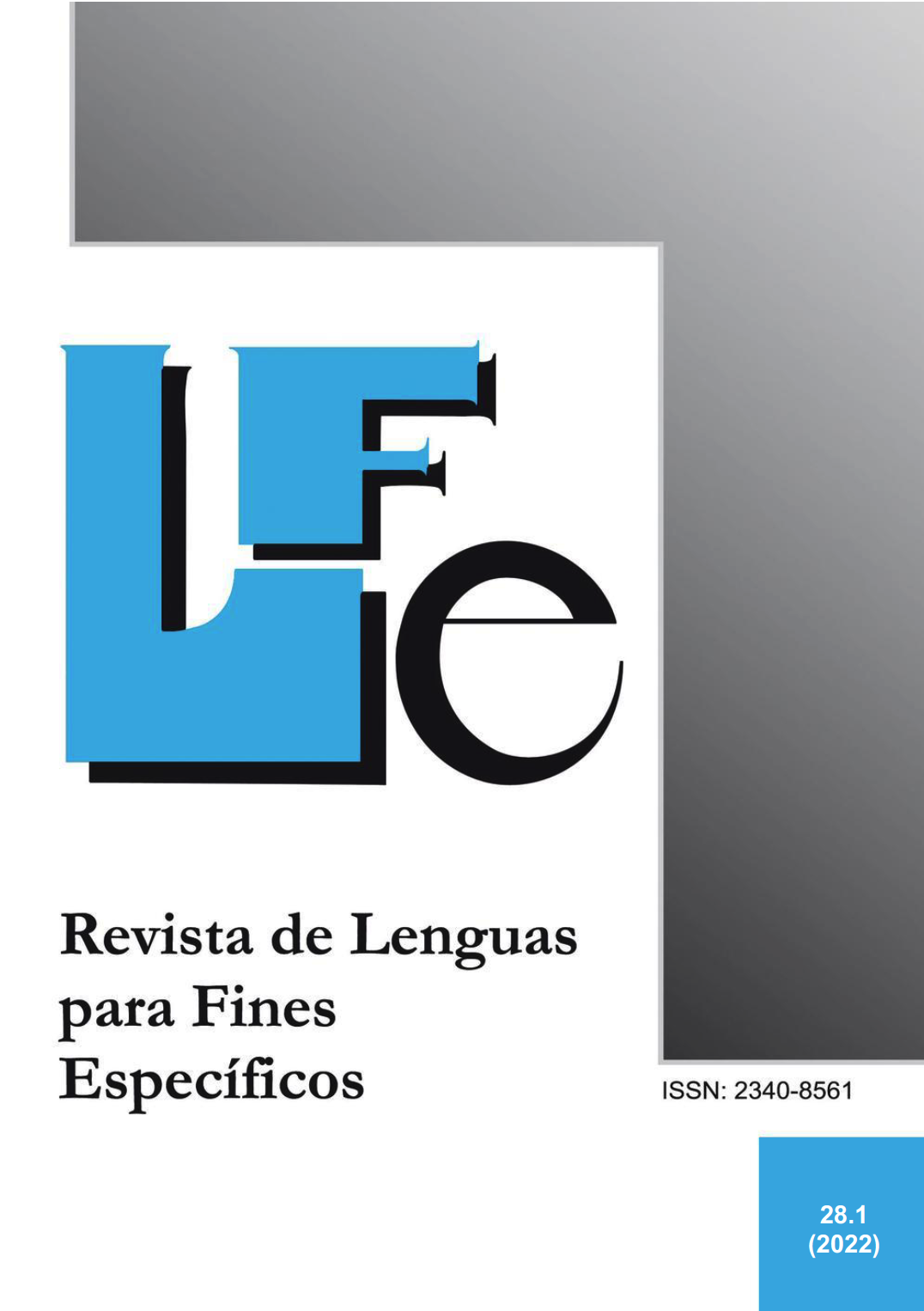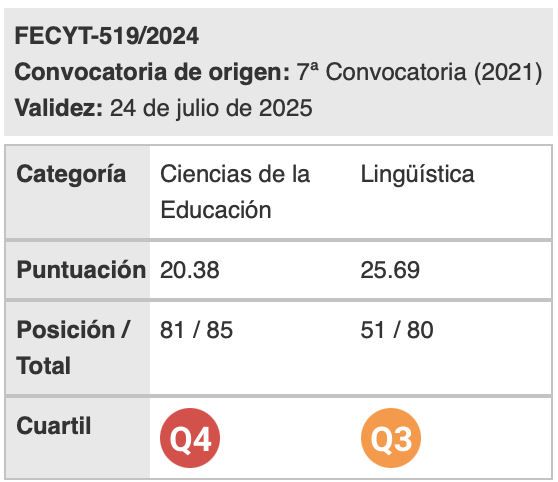Los estilos de aprendizaje de percepción de alumnos monolingües y bilingües aprendientes de Inglés como lengua extranjera
Palabras clave:
Perceptual learning style preferences, Monolinguals, Bilinguals, EFL learners, 12th gradeResumen
El presente estudio exploró los estilos de aprendizaje de percepción de alumnos monolingües y bilingües aprendientes de Inglés como lengua extranjera. Esta comparación permitiría conocer si utilizan estilos de aprendizaje similares o diferentes. También ofrecería una visión de cómo se aprende Inglés en un curso escolar y una comunidad determinadas. Esta investigación tuvo un objetivo doble: (1) identificar los más y menos preferidos estilos de aprendizaje de los alumnos monolingües y bilingües; (2) determinar si se encontraron diferencias estadísticamente significativas entre el perfil lingüístico de estos estudiantes y sus estilos de aprendizaje. La muestra estaba formada por 60 aprendientes de Inglés como lengua extranjera (47 monolingües y 13 bilingües) que cursaban 2º de Bachillerato. Se utilizó el instrumento Learning Style Survey (LSS) (Cohen et al., 2009) para medir los estilos de aprendizaje. Los resultados indicaron que los alumnos monolingües y bilingües prefirieron el estilo de aprendizaje visual, mientras que el estilo auditivo fue el menos preferido. No se encontraron diferencias estadísticamente significativas entre los perfiles lingüísticos de los estudiantes y los estilos de aprendizaje, y el tamaño del efecto fue pequeño. Por tanto, se puede deducir que el hecho de ser monolingüe o bilingüe no afecta las preferencias que los estudiantes tienen al aprender Inglés.
Descargas
Citas
Abdollahzadeh, E., & Amiri, N. (2009). The effect of semantic mapping as a vocabulary instruction technique on EFL learners with different perceptual learning styles. The Journal of Applied Linguistics, 2(1), 1-27.
Aliweh, A. M. (2011). Exploring Egyptian EFL students’ learning styles and satisfaction with web-based materials. CALICO Journal, 29(1), 81-99.
Barbe, W. B., & Swassing, R. H. (1979). Teaching through modality strengths: concepts and practices. Columbus: Zaner-Bloser.
Becker, L. A. (1998). Effect Size Calculators. University of Colorado, Colorado Springs. <https://www.uccs.edu/lbecker/> [18/07/2021].
Chislett, V., & Chapman, A. (2005). VAK Learning Styles Self-Assessment Questionnaire. <https://www.businessballs.com/freepdf materials/vak_learning_styles_questionnaire.pdf> [18/07/2021].
Coffield, F., Moseley, D., Hall, E., & Ecclestone, K. (2004). Should we be using learning styles? What research has to say to practice. London: Learning and Skills Research Centre.
Cohen, A. D., Oxford, R. L., & Chi, J. C. (2009). Learning Style Survey: Assessing your own learning styles. Minnesota: Center for Advanced Research on Language Acquisition.
Cohen, A. D., & Weaver, S. J. (2005). Styles and strategies-based instruction: A teachers’ guide. Minnesota: Center for Advanced Research on Language Acquisition.
Curry, L. (1990). A critique of the research on learning styles. Educational Leadership, 11(3-4), 247-277.
Derakhshan, A., & Shakki, F. (2018). An investigation into the relationship between Iranian EFL high- and low- proficient learners and their learning styles. SAGE Open, 8(4), 1-10.
Dörnyei, Z. (2005). The Psychology of the Language Learner: Individual Differences in Second Language Acquisition. Mahwah: Lawrence Erlbaum Associates.
Dörnyei, Z., & Ryan, S. (2015). The psychology of the language learner: Revisited. New York: Routledge.
Fleming, N. D. (2001). Teaching and learning styles: VARK strategies. Christchurch: N.D. Fleming.
Gholam-Shahbazi, H. (2019). The relationship between spatial and musical intelligences and EFL learners’ learning styles and vocabulary knowledge. Journal of Language Teaching and Research, 10(4), 747-765.
Gibbons, P. (2015). Scaffolding language, scaffolding learning: Teaching English language learners in the mainstream classroom (2nd ed.). Portsmouth: Heinemann.
Gilakjani, A. P. (2012). Visual, auditory, kinaesthetic learning styles and their impacts on English language teaching. Journal of Studies in Education, 2(1), 104-113.
Goh, C. C. M. (2002). Exploring listening comprehension tactics and their interaction patterns. System, 30, 185-206.
Griffiths, C. (2012). Learning Styles: Traversing the Quagmire. In S. Mercer, S. Ryan, & M. Williams (Eds.), Psychology for Language Learning: Insights from Research, Theory, and Practice (pp. 151–168). Basingstoke: Palgrave Macmillan.
Hatami, S. (2018). Does perceptual learning style matching affect L2 incidental vocabulary acquisition through reading? Canadian Journal of Applied Linguistics, 21(2), 102-125.
Hutchinson, T., & Torres, E. (1994). The textbook as agent of change. ELT Journal, 48(4), 315-328.
Hyland, K. (1993). Culture and learning: A study of the learning style preference of Japanese students. RELC Journal, 24(2), 69-87.
Jiménez Catalán, R. M., & Mancebo Francisco, R. (2008). Vocabulary input in EFL textbooks. RESLA, 21, 147-165.
Keefe, J. W. (1988). Development of the NAASP Learning Style Profile. In J. W. Keefe (Ed.), Profiling & utilizing learning style (pp. 1–21). Reston: National Association of Secondary School Principals.
Kim, T.-Y., & Kim, M. (2018). Relationships among perceptual learning style, the ideal L2 self, and motivated L2 behavior in college language learners. Porta Linguarum, 30, 7-22.
Kinsella, K. (1995). Perceptual learning preference survey. In J. M. Reid (Ed.), Learning styles in the ESL/EFL classroom (pp. 221–238). New York: Heinle & Heinle Publishers.
Lee, B., & Kim, H. (2014). What can we learn from our learners’ learning styles? English Language Teaching, 7(9), 118-131.
Li, H., & He, Q. (2016). Ambiguity tolerance and perceptual learning styles of Chinese EFL learners. English Language Teaching, 9(6), 213-222.
Nushi, M., & Orouji, F. (2020). Investigating EFL teachers’ views on listening difficulties among their learners: the case of Iranian context. SAGE Open, 10(2), 1-16.
Oxford, R. L. (1995). Style Analysis Survey (SAS): Assessing your own learning working learning styles. In J. M. Reid (Ed.), Learning styles in the ESL/EFL classroom (pp. 208–215). New York: Heinle & Heinle Publishers.
Pashler, H., McDaniel, M., Rohrer, D., & Bjork, R. (2009). Learning Styles: Concepts and Evidence. Association for Psychological Science, 9(3), 105-119.
Peacock, M. (2001). Match or mismatch? Learning styles and teaching styles in EFL. International Journal of Applied Linguistics, 11(1), 1-20.
Psaltou-Joycey, A., & Kantaridou, Z. (2009). Plurilingualism, language learning strategy use and learning style preferences. International Journal of Multilingualism, 6(4), 460-474.
Reid, J. M. (1995). Perceptual Learning Style Preference Questionnaire. In J. M. Reid (Ed.), Learning styles in the ESL/EFL classroom (pp. 202–207). New York: Heinle & Heinle Publishers.
Salbego, N., Heberle, V. M., & Soares da Silva Belen, M. G. (2015). A visual analysis of English textbooks: Multimodal scaffolded learning. Calidoscópio, 13(1), 5-13.
Shen, M. (2010). Effects of perceptual learning style preferences on L2 lexical inferencing. System, 38, 539-547.
Tight, D. G. (2010). Perceptual Learning Style Matching and L2 Vocabulary Acquisition. Language Learning, 60(4), 792-833.
Vandergrift, L. (2007). Recent developments in second and foreign language listening comprehension research. Language Teaching, 40, 191-210.
Willingham, D. T. (2005). Do visual, auditory, and kinesthetic learners need visual, auditory, and kinesthetic instruction? American Educator, 29(2), 31-35.
Zarei, G. R., & Pourghasemian, H. (2016). Mediational role of perceptual styles in L2 lexical inferencing and the associated strategy use. 3L: The Southeast Asian Journal of English Language Studies, 22(1), 179-189.
Zokaee, S., Zaferanieh, E., & Naseri, M. (2012). On the impacts of perceptual learning style and gender on Iranian undergraduate EFL learners’ choice of vocabulary learning strategies. English Language Teaching, 5(9), 138-143.
Descargas
Publicado
Cómo citar
Número
Sección
Licencia
Aquellos autores/as que tengan publicaciones con esta revista, aceptan los términos siguientes:
- Los autores/as conservarán sus derechos de autor y garantizarán a la revista el derecho de primera publicación de su obra, el cuál estará simultáneamente sujeto a la Licencia de reconocimiento de Creative Commons que permite a terceros compartir la obra siempre que se indique su autor y su primera publicación esta revista.
- Los autores/as podrán adoptar otros acuerdos de licencia no exclusiva de distribución de la versión de la obra publicada (p. ej.: depositarla en un archivo telemático institucional o publicarla en un volumen monográfico) siempre que se indique la publicación inicial en esta revista.
- Se permite y recomienda a los autores/as difundir su obra a través de Internet (p. ej.: en archivos telemáticos institucionales o en su página web) antes y durante el proceso de envío, lo cual puede producir intercambios interesantes y aumentar las citas de la obra publicada. (Véase El efecto del acceso abierto).

Revista de Lenguas para fines específicos is licensed under a Creative Commons Reconocimiento-NoComercial-SinObraDerivada 4.0 Internacional License.























